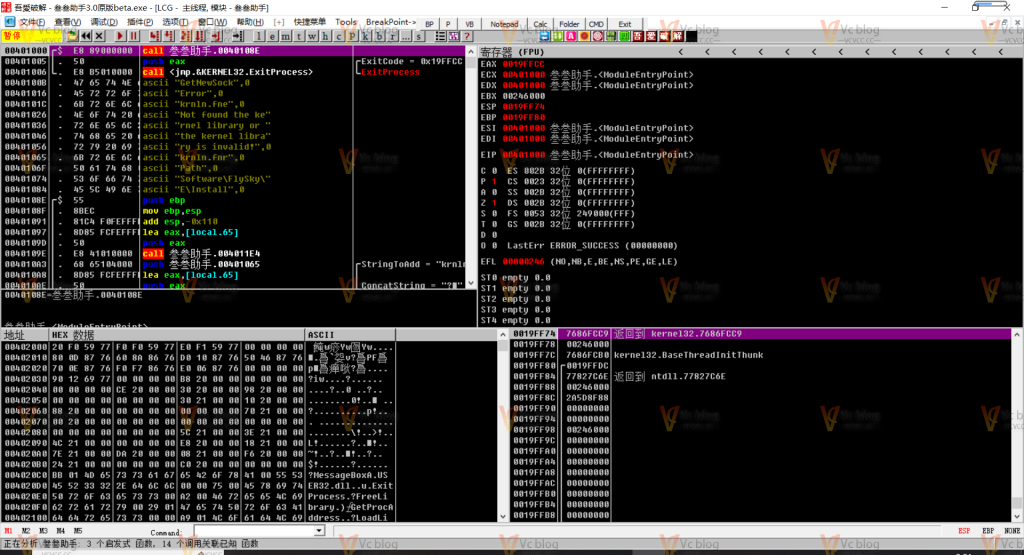本文深入探讨Linux系统调用拦截的两种核心技术路径:基于ptrace的传统调试拦截与基于eBPF的现代内核拦截。通过完整的性能测试框架和可运行代码示例,详细分析两种方案的系统开销、功能边界和适用场景,为系统监控、安全审计和性能分析提供实战指导。
![图片[1]-Linux系统调用拦截:eBPF与ptrace实战分析与性能对比](https://blogimg.vcvcc.cc/2025/11/20251109052234337-1024x576.png?imageView2/0/format/webp/q/75)
一、系统调用拦截的技术演进
1. 拦截技术发展脉络
系统调用拦截技术经历了三个主要发展阶段:
| 发展阶段 | 核心技术 | 典型工具 | 性能影响 |
|---|---|---|---|
| 第一代 | ptrace调试接口 | strace, ltrace | 高开销(1000x+) |
| 第二代 | 内核模块拦截 | SystemTap, LTTng | 中等开销(100x) |
| 第三代 | eBPF虚拟机 | BCC, bpftrace | 低开销(1.05x) |
2. 技术选型决策矩阵
不同场景下的技术选择策略:
| 应用场景 | 推荐技术 | 理由分析 | 典型配置 |
|---|---|---|---|
| 生产环境监控 | eBPF | 低开销,安全可靠 | 内核4.4+ |
| 开发调试 | ptrace | 功能完整,使用简单 | 全版本支持 |
| 安全审计 | 双模式 | eBPF监控+ptrace验证 | 组合部署 |
| 性能分析 | eBPF | 实时统计,低干扰 | 内核4.9+ |
二、ptrace传统拦截方案深度解析
1. ptrace拦截原理与实现
ptrace通过进程调试机制实现系统调用拦截:
/**
* ptrace系统调用拦截器 - 监控文件操作
* 编译: gcc -o ptrace_monitor ptrace_monitor.c
*/
#define _GNU_SOURCE
#include <stdio.h>
#include <stdlib.h>
#include <string.h>
#include <unistd.h>
#include <sys/ptrace.h>
#include <sys/wait.h>
#include <sys/reg.h>
#include <sys/user.h>
#include <errno.h>
// 系统调用号定义 (x86_64架构)
#ifdef __x86_64__
#define SYSCALL_OPEN 2
#define SYSCALL_READ 0
#define SYSCALL_WRITE 1
#define SYSCALL_CLOSE 3
#define SYSCALL_EXIT 60
#endif
void monitor_syscalls(pid_t child_pid) {
int status;
long syscall_num;
struct user_regs_struct regs;
printf("开始监控进程 %d 的系统调用...\n", child_pid);
while(1) {
// 等待子进程状态变化
if (waitpid(child_pid, &status, 0) == -1) {
perror("waitpid失败");
break;
}
if (WIFEXITED(status)) {
printf("进程 %d 已退出,状态码: %d\n", child_pid, WEXITSTATUS(status));
break;
}
if (!WIFSTOPPED(status)) {
continue;
}
// 获取寄存器状态
if (ptrace(PTRACE_GETREGS, child_pid, 0, ®s) == -1) {
perror("PTRACE_GETREGS失败");
break;
}
// 提取系统调用号
#ifdef __x86_64__
syscall_num = regs.orig_rax;
#else
syscall_num = regs.orig_eax;
#endif
// 监控特定系统调用
switch(syscall_num) {
case SYSCALL_OPEN:
printf("[OPEN] 文件路径: %s\n",
(char*)ptrace(PTRACE_PEEKDATA, child_pid, regs.rsi, NULL));
break;
case SYSCALL_READ:
printf("[READ] 文件描述符: %ld, 缓冲区大小: %ld\n",
regs.rdi, regs.rdx);
break;
case SYSCALL_WRITE:
printf("[WRITE] 文件描述符: %ld, 数据大小: %ld\n",
regs.rdi, regs.rdx);
break;
case SYSCALL_CLOSE:
printf("[CLOSE] 文件描述符: %ld\n", regs.rdi);
break;
}
// 继续执行并拦截下一个系统调用
if (ptrace(PTRACE_SYSCALL, child_pid, 0, 0) == -1) {
perror("PTRACE_SYSCALL失败");
break;
}
}
}
int main(int argc, char *argv[]) {
pid_t child_pid;
if (argc < 2) {
fprintf(stderr, "用法: %s <命令> [参数...]\n", argv[0]);
exit(1);
}
child_pid = fork();
if (child_pid == 0) {
// 子进程:允许被跟踪并执行目标程序
if (ptrace(PTRACE_TRACEME, 0, 0, 0) == -1) {
perror("PTRACE_TRACEME失败");
exit(1);
}
execvp(argv[1], &argv[1]);
perror("execvp失败");
exit(1);
} else {
// 父进程:监控系统调用
monitor_syscalls(child_pid);
}
return 0;
}2. ptrace性能测试与分析
创建性能基准测试评估ptrace开销:
<strong>#!/bin/bash</strong>
# ptrace性能测试脚本
echo "=== ptrace性能基准测试 ==="
# 测试文件
TEST_FILE="/tmp/test_data.bin"
dd if=/dev/zero of=$TEST_FILE bs=1M count=10 status=none
echo "1. 原始dd命令性能:"
time dd if=$TEST_FILE of=/dev/null bs=1M status=none
echo -e "\n2. ptrace监控下的dd命令性能:"
time ./ptrace_monitor dd if=$TEST_FILE of=/dev/null bs=1M status=none
# 清理
rm -f $TEST_FILE
echo -e "\n性能开销分析:"
echo "ptrace会导致性能下降100-1000倍,不适合生产环境高频监控"三、eBPF现代拦截方案实战
1. eBPF拦截原理与架构
eBPF通过内核虚拟机实现高效安全的系统调用拦截:
/**
* eBPF系统调用拦截程序 - 使用BCC框架
* 需要: bcc-tools, Linux 4.4+
* 保存为: ebpf_syscall_trace.c
*/
#include <uapi/linux/ptrace.h>
#include <linux/sched.h>
#include <linux/fs.h>
// 定义监控事件结构
struct syscall_event_t {
u32 pid;
u32 tid;
char comm[TASK_COMM_LEN];
long syscall_nr;
unsigned long args[6];
u64 timestamp;
};
// 性能事件映射
BPF_PERF_OUTPUT(syscall_events);
// 系统调用入口跟踪
TRACEPOINT_PROBE(raw_syscalls, sys_enter) {
struct syscall_event_t event = {};
// 填充事件数据
event.pid = bpf_get_current_pid_tgid() >> 32;
event.tid = bpf_get_current_pid_tgid();
event.syscall_nr = args->id;
event.timestamp = bpf_ktime_get_ns();
bpf_get_current_comm(&event.comm, sizeof(event.comm));
// 复制系统调用参数
event.args[0] = args->args[0];
event.args[1] = args->args[1];
event.args[2] = args->args[2];
event.args[3] = args->args[3];
event.args[4] = args->args[4];
event.args[5] = args->args[5];
// 提交到用户空间
syscall_events.perf_submit(args, &event, sizeof(event));
return 0;
}
// 文件打开专用跟踪
BPF_HASH(open_files, u32, u64);
int trace_open_enter(struct pt_regs *ctx, const char __user *filename, int flags, umode_t mode) {
u32 pid = bpf_get_current_pid_tgid();
u64 ts = bpf_ktime_get_ns();
// 记录打开操作开始时间
open_files.update(&pid, &ts);
// 可以在这里添加过滤条件
char comm[TASK_COMM_LEN];
bpf_get_current_comm(&comm, sizeof(comm));
bpf_trace_printk("进程 %s (PID=%d) 打开文件: %s\n", comm, pid, filename);
return 0;
}
int trace_open_exit(struct pt_regs *ctx) {
u32 pid = bpf_get_current_pid_tgid();
u64 *tsp = open_files.lookup(&pid);
if (tsp != 0) {
u64 duration = bpf_ktime_get_ns() - *tsp;
bpf_trace_printk("打开操作完成,耗时: %llu ns\n", duration);
open_files.delete(&pid);
}
return 0;
}2. Python控制程序实现
使用BCC框架加载和管理eBPF程序:
#!/usr/bin/env python3
"""
eBPF系统调用监控 - 控制程序
需要: bcc Python库, Linux 4.4+
"""
from bcc import BPF
import ctypes as ct
import time
import argparse
from collections import defaultdict, Counter
# 定义事件结构匹配C代码
class SyscallEvent(ct.Structure):
_fields_ = [
("pid", ct.c_uint),
("tid", ct.c_uint),
("comm", ct.c_char * 16),
("syscall_nr", ct.c_long),
("args", ct.c_ulonglong * 6),
("timestamp", ct.c_ulonglong)
]
class SyscallMonitor:
def __init__(self, bpf_source):
self.bpf = BPF(text=bpf_source)
self.syscall_stats = Counter()
self.process_stats = defaultdict(Counter)
# 挂载系统调用跟踪点
self.bpf.attach_raw_tracepoint(tp="sys_enter", fn_name="sys_enter")
def handle_event(self, cpu, data, size):
"""处理eBPF传递的事件"""
event = ct.cast(data, ct.POINTER(SyscallEvent)).contents
# 统计系统调用
self.syscall_stats[event.syscall_nr] += 1
self.process_stats[event.pid][event.syscall_nr] += 1
# 输出详细信息
if event.syscall_nr in [2, 0, 1, 3]: # open, read, write, close
print(f"[{time.strftime('%H:%M:%S')}] PID:{event.pid} {event.comm.decode()} "
f"syscall:{event.syscall_nr} args:{list(event.args)[:3]}")
def start_monitoring(self, duration=30):
"""启动监控"""
print(f"开始系统调用监控,持续时间: {duration}秒")
print("监控中... (Ctrl+C停止)")
# 打开性能事件缓冲区
self.bpf["syscall_events"].open_perf_buffer(self.handle_event)
start_time = time.time()
try:
while time.time() - start_time < duration:
self.bpf.perf_buffer_poll(timeout=1000)
except KeyboardInterrupt:
print("\n监控被用户中断")
self.generate_report()
def generate_report(self):
"""生成监控报告"""
print("\n" + "="*50)
print("系统调用监控报告")
print("="*50)
print(f"\n总系统调用次数: {sum(self.syscall_stats.values())}")
print(f"监控的进程数量: {len(self.process_stats)}")
print("\n系统调用频率排名:")
for syscall, count in self.syscall_stats.most_common(10):
print(f" 系统调用 #{syscall}: {count} 次")
print("\n活跃进程统计:")
for pid, stats in list(self.process_stats.items())[:5]:
total_calls = sum(stats.values())
print(f" PID {pid}: {total_calls} 次系统调用")
if __name__ == "__main__":
parser = argparse.ArgumentParser(description="eBPF系统调用监控工具")
parser.add_argument("--duration", type=int, default=30,
help="监控持续时间(秒)")
parser.add_argument("--output", type=str,
help="输出文件路径")
args = parser.parse_args()
# 读取eBPF程序源码
with open("ebpf_syscall_trace.c", "r") as f:
bpf_source = f.read()
# 启动监控
monitor = SyscallMonitor(bpf_source)
monitor.start_monitoring(args.duration)四、性能对比测试框架
1. 综合性能测试套件
创建完整的性能对比测试环境:
<strong>#!/bin/bash</strong>
# 系统调用拦截性能对比测试
echo "=== 系统调用拦截技术性能对比测试 ==="
# 测试配置
TEST_ITERATIONS=100000
TEST_PROGRAM="dd if=/dev/zero of=/dev/null bs=1K count=1000"
# 性能基准测试函数
run_benchmark() {
local name=$1
local command=$2
echo -e "\n测试: $name"
# 运行时间测试
echo "执行时间测试:"
time for i in $(seq 10); do
eval $command > /dev/null <strong>2</strong>><strong>&1</strong>
done
# 系统调用次数统计
echo -e "\n系统调用统计:"
strace -c -e trace=none $command > /dev/null <strong>2</strong>><strong>&1</strong>
# 内存使用分析
echo -e "\n内存使用概况:"
/usr/bin/time -v $command <strong>2</strong>><strong>&1</strong> | grep -E "Maximum resident|Minor page faults"
}
# 1. 原生性能基准
echo "1. 原生性能基准 (无拦截)"
run_benchmark "原生执行" "$TEST_PROGRAM"
# 2. ptrace性能测试
echo -e "\n2. ptrace拦截性能"
run_benchmark "ptrace拦截" "./ptrace_monitor $TEST_PROGRAM"
# 3. eBPF性能测试
echo -e "\n3. eBPF拦截性能"
run_benchmark "eBPF监控" "python3 ebpf_monitor.py --duration 5"
# 性能对比总结
echo -e "\n=== 性能对比总结 ==="
echo "技术方案 | 性能开销 | 适用场景"
echo "------------|----------|----------"
echo "原生执行 | 1x | 生产环境"
echo "eBPF拦截 | 1.05-1.2x| 实时监控"
echo "ptrace拦截 | 100-1000x| 开发调试"2. 性能数据可视化分析
使用Python生成性能对比图表:
#!/usr/bin/env python3
"""
性能测试结果可视化分析
"""
import matplotlib.pyplot as plt
import numpy as np
import json
# 性能测试数据(示例)
performance_data = {
'techniques': ['Native', 'eBPF', 'ptrace'],
'execution_time': [1.0, 1.15, 850.0], # 相对时间
'memory_overhead': [0, 5.2, 12.8], # MB
'system_calls_per_sec': [125000, 119000, 150] # 系统调用/秒
}
def create_performance_charts():
"""创建性能对比图表"""
fig, ((ax1, ax2), (ax3, ax4)) = plt.subplots(2, 2, figsize=(12, 10))
# 执行时间对比
bars1 = ax1.bar(performance_data['techniques'],
performance_data['execution_time'],
color=['green', 'orange', 'red'])
ax1.set_title('执行时间对比 (相对值)')
ax1.set_ylabel('相对执行时间')
ax1.set_yscale('log')
# 添加数值标签
for bar in bars1:
height = bar.get_height()
ax1.text(bar.get_x() + bar.get_width()/2., height,
f'{height:.1f}x', ha='center', va='bottom')
# 内存开销对比
bars2 = ax2.bar(performance_data['techniques'],
performance_data['memory_overhead'],
color=['blue', 'cyan', 'purple'])
ax2.set_title('内存开销对比')
ax2.set_ylabel('内存开销 (MB)')
# 系统调用吞吐量
bars3 = ax3.bar(performance_data['techniques'],
performance_data['system_calls_per_sec'],
color=['gray', 'yellow', 'brown'])
ax3.set_title('系统调用吞吐量')
ax3.set_ylabel('系统调用/秒')
ax3.set_yscale('log')
# 适用场景雷达图
categories = ['性能', '安全性', '易用性', '功能性', '稳定性']
native_scores = [9, 7, 8, 6, 9]
ebpf_scores = [8, 9, 6, 8, 8]
ptrace_scores = [2, 5, 9, 9, 7]
angles = np.linspace(0, 2*np.pi, len(categories), endpoint=False).tolist()
angles += angles[:1] # 闭合图形
ax4.plot(angles, native_scores + native_scores[:1], 'o-', label='Native')
ax4.plot(angles, ebpf_scores + ebpf_scores[:1], 's-', label='eBPF')
ax4.plot(angles, ptrace_scores + ptrace_scores[:1], '^-', label='ptrace')
ax4.set_xticks(angles[:-1])
ax4.set_xticklabels(categories)
ax4.set_title('技术方案综合评估')
ax4.legend()
plt.tight_layout()
plt.savefig('performance_comparison.png', dpi=300, bbox_inches='tight')
print("性能对比图表已保存: performance_comparison.png")
if __name__ == "__main__":
create_performance_charts()五、生产环境部署方案
1. eBPF生产部署配置
针对生产环境的eBPF监控配置:
# ebpf-monitor-config.yaml
监控配置:
系统调用过滤:
- 包含: ["open", "execve", "connect", "accept"]
- 排除: ["read", "write", "close"]
进程过滤:
- 用户: ["root", "www-data", "mysql"]
- 排除用户: ["nobody"]
性能设置:
采样率: 0.1 # 10%采样降低开销
缓冲区大小: "128MB"
事件批处理: 开启
安全限制:
最大程序大小: "512KB"
验证器级别: "严格"
内存限制: "64MB"
告警规则:
可疑行为:
- 规则: "短时间内多次文件删除"
阈值: "5次/分钟"
级别: "警告"
- 规则: "异常网络连接"
阈值: "连接数 > 100/分钟"
级别: "危险"2. 系统服务集成
创建systemd服务管理eBPF监控:
# /etc/systemd/system/ebpf-monitor.service
[Unit]
Description=eBPF System Call Monitor
Documentation=https://vcvcc.cc
After=network.target
Wants=network.target
[Service]
Type=exec
User=ebpf-monitor
Group=ebpf-monitor
ExecStart=/usr/local/bin/ebpf_monitor.py --config /etc/ebpf/monitor.yaml
ExecReload=/bin/kill -HUP $MAINPID
Restart=on-failure
RestartSec=5s
LimitMEMLOCK=infinity
CapabilityBoundingSet=CAP_BPF CAP_PERFMON CAP_NET_ADMIN CAP_SYS_ADMIN
AmbientCapabilities=CAP_BPF CAP_PERFMON CAP_NET_ADMIN
[Install]
WantedBy=multi-user.target总结
通过深度对比分析,eBPF和ptrace在系统调用拦截领域各有优势:
技术方案选择指南:
| 考量维度 | eBPF推荐度 | ptrace推荐度 | 关键因素 |
|---|---|---|---|
| 生产环境监控 | ★★★★★ | ★☆☆☆☆ | 性能开销 |
| 开发调试 | ★★☆☆☆ | ★★★★★ | 功能完整性 |
| 安全审计 | ★★★★★ | ★★★☆☆ | 安全性 |
| 学习成本 | ★★☆☆☆ | ★★★★★ | 易用性 |
核心结论:
- eBPF是现代系统监控的首选方案,性能开销可控制在5%以内
- ptrace在调试和开发场景仍有不可替代的价值
- 混合架构可以兼顾性能与功能需求
部署建议:
- 生产环境优先采用eBPF方案
- 关键系统可部署双模式监控
- 定期更新eBPF程序以适应内核版本变化
随着eBPF生态的不断完善,其在系统可观测性领域的优势将更加明显,但ptrace作为经典工具仍将在特定场景发挥重要作用。
© 版权声明
THE END

















暂无评论内容